Professional Steel Fabricators Melbourne: Quality You Can Trust Fund
Cutting-edge Trends in Steel Fabrication: Enhancing Sturdiness and Precision
In the world of steel construction, the quest of resilience and precision has actually resulted in a wave of cutting-edge patterns that are reshaping the sector. From improvements in welding technologies to the assimilation of robot automation in fabrication processes, the landscape of steel production is advancing quickly. High-strength alloy advancement, paired with the utilization of 3D modeling and simulation software, is pushing the boundaries of what is attainable in regards to structural stability and precision. In addition, the growing focus on sustainable practices in steel manufacturing is not just driving effectiveness but likewise fostering a much more eco conscious method to fabrication. These patterns are not just forming the here and now yet additionally preparing for the future of steel construction, guaranteeing further improvements in toughness and accuracy.
Advanced Welding Technologies
In the realm of steel fabrication, the fostering of cutting-edge welding modern technologies has considerably reinvented the sector's technique to attaining remarkable quality and precision in architectural welds. Advanced welding modern technologies, such as laser light beam welding and rubbing stir welding, have emerged as game-changers in the field. Laser beam welding employs a concentrated laser light beam to sign up with steel elements with exceptional accuracy and rate, making it suitable for complex styles and thin materials. On the various other hand, rubbing mix welding creates unbelievably solid bonds by mechanically intermixing the particles of the materials at the joint, eliminating the requirement for melting the metal. These modern technologies supply countless advantages, consisting of decreased heat-affected areas, very little distortion, and enhanced mechanical residential properties in the bonded joints. By leveraging these sophisticated welding methods, steel makers can raise the toughness, stamina, and precision of their architectural welds, meeting the increasingly requiring demands of modern construction jobs.
Robotic Automation in Manufacture
Embracing robotic automation has come to be a foundation of modern-day steel manufacture practices, enhancing procedures and enhancing efficiency across the market. Robotics are revolutionizing the method steel elements are made, supplying unrivaled accuracy and rate while lowering human error. These automated systems can handle recurring tasks with consistent accuracy, resulting in greater top quality end items.
One key advantage of robotic automation in steel construction is the capability to work all the time without tiredness, substantially boosting manufacturing outcome. This continuous operation decreases downtime and increases project timelines, eventually conserving costs for manufacturers. Additionally, robots can be programmed to carry out elaborate tasks that may be dangerous or difficult for human workers, improving safety in the work environment.
Additionally, robot automation allows seamless combination with various other digital modern technologies, such as computer-aided design (CAD) software program and Net of Things (IoT) systems (steel fixing). This interconnected method improves interaction in between different stages of manufacture, optimizing process and making certain real-time monitoring and control. As the steel construction market remains to evolve, robotic automation sticks out as a transformative pressure driving efficiency and precision in producing procedures

High-Strength Alloy Growth
The advancement of high-strength alloy development in steel fabrication is reshaping the sector's method to improving material resilience and performance. High-strength alloys are engineered to exhibit superior mechanical homes, such as enhanced tensile stamina, strength, and rust resistance compared to traditional steel qualities. By integrating these sophisticated alloys into construction processes, manufacturers can create elements that stand up to higher stress degrees and rough environments, bring about even more reliable and long lasting final product.
One secret benefit of high-strength alloy growth is the capability to decrease product density without jeopardizing structural honesty. This not just results in lighter-weight components yet likewise adds to set you back savings and improved effectiveness in construction and setting up procedures. The boosted strength-to-weight ratio of these alloys permits for the design and building and construction of structures with greater load-bearing capacities while decreasing overall weight.
3D Modeling and Simulation Software Program
Advancements in steel fabrication processes have been dramatically thrust by the combination of innovative 3D modeling and simulation software application devices. These devices enable producers to develop thorough digital versions of their jobs, enabling them to picture the final product with precision before any physical job starts.

Sustainable Practices in Steel Production
Including sustainable methods into steel manufacturing procedures is important for decreasing environmental influence and guaranteeing lasting resource schedule. One key lasting technique is the adoption of energy-efficient modern technologies to reduce greenhouse gas discharges throughout the steel manufacturing process. This consists of using sustainable power sources, such as solar or wind power, to click to investigate power steel plants and executing energy-efficient tools to maximize energy usage.
One more crucial aspect of lasting steel production is the responsible sourcing of basic materials. This entails ensuring that the iron ore and other resources utilized in steelmaking are gotten from ethical and ecologically pleasant resources. By advertising openness in the supply chain and adhering to strict environmental criteria, steel producers can lessen the adverse influences of resource extraction on neighborhood ecosystems and neighborhoods.

Final Thought
In final thought, the innovative trends in steel manufacture such as sophisticated welding technologies, robot automation, high-strength alloy development, 3D modeling and simulation software, and lasting practices are boosting the durability and accuracy of steel products. These innovations are changing the steel construction industry by boosting performance, sustainability, and quality. It is clear that the future of steel fabrication depends on accepting these additional hints sophisticated innovations to satisfy the needs of modern-day building and construction and manufacturing sectors.
In the realm of steel manufacture, the pursuit of durability and accuracy has led to a wave of ingenious fads that are reshaping the market.In the world of steel construction, the fostering of cutting-edge welding innovations has dramatically revolutionized the sector's strategy to attaining exceptional quality and precision in architectural welds. As the steel manufacture sector proceeds to advance, robotic automation stands out as a transformative force driving effectiveness and accuracy in manufacturing processes.
Furthermore, recycling and recycling steel scrap and waste products play a substantial role in boosting the sustainability of steel manufacturing. steel fixing.In final thought, the cutting-edge trends in steel fabrication such as sophisticated welding modern technologies, robot automation, high-strength alloy advancement, 3D modeling and simulation software program, and sustainable practices are boosting the longevity and accuracy of steel products